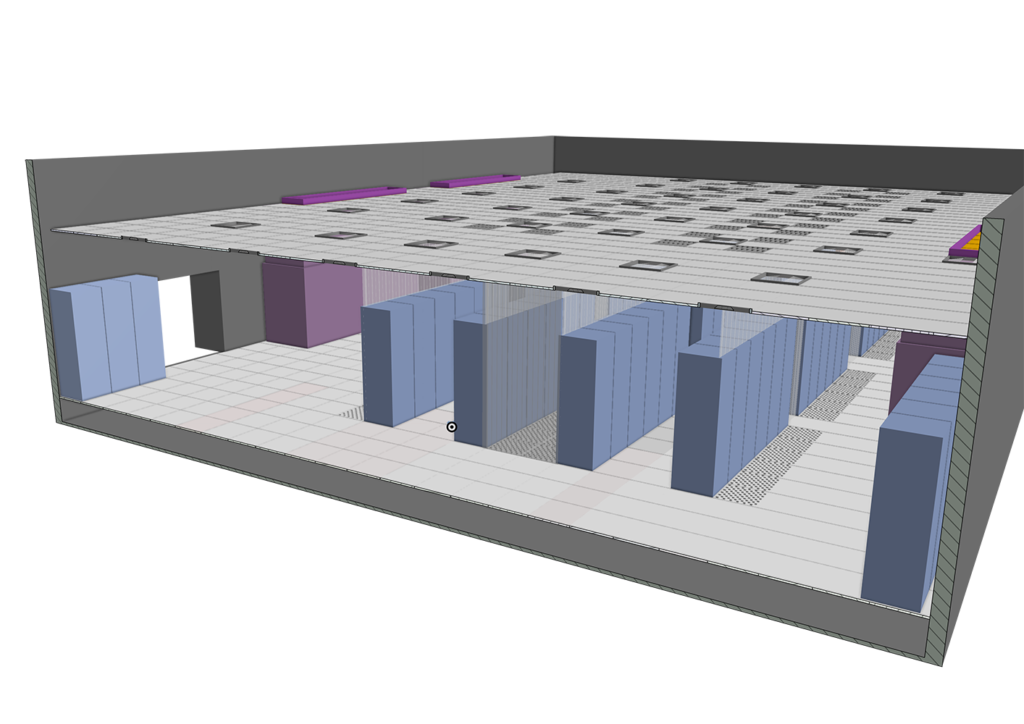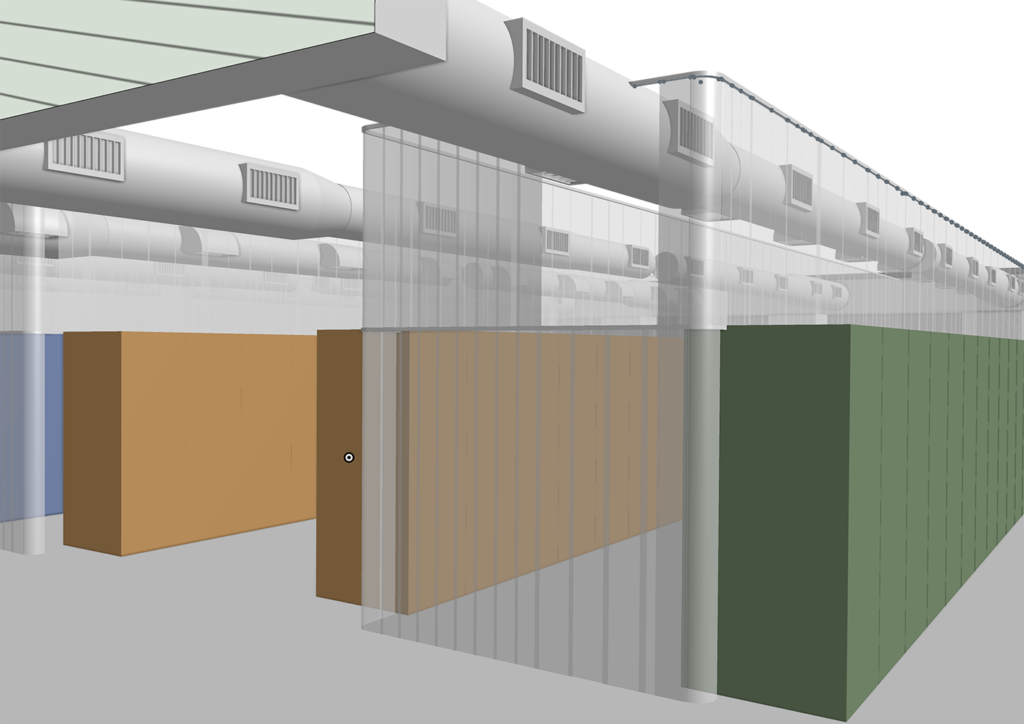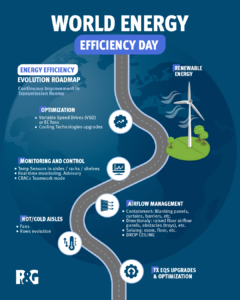Environmental sustainability is an increasingly significant part of technology sector conversations. Companies broadcast their latest environmental updates, debate carbon reduction plans, and let their investors know that transformation is good not only for the environment, but also for the bottom line. And yet, amidst all of the discussion of why sustainability, there is little information on how. What is the path to becoming sustainable? Renewable energy? Building efficiencies? And what if your facilities are old and inefficient: should you upgrade, or build anew?
One strategy has been to “green” the cable landing station (CLS). BT, for example, has made changes at their CLSs, including efficiency improvements (i.e. increasing the standard temperature), as well as a shift from refrigerant cooling to free-air cooling. Even for zero-carbon operators, such as the cable landing station campus NJFX, efficiency remains key. “Energy efficiency is always at the forefront when considering design in power intensive critical infrastructure,” NJFX CEO Gil Santaliz reports. Echoing this, Stine Holthe of Bulk Infrastructure (whose Norwegian cable station and data centers are indeed powered by hydropower) observes: “Even when a station is powered by renewable energy it is still critical to think about efficiency.” And yet, this path to a green CLS is not always simple, nor straightforward. Possible solutions are often constrained by technological, physical space, and environmental limitations.
The Sustainable Subsea column, brought to you by the SubOptic Foundation’s Sustainable Subsea Networks research project, not only relays best practices, but also describes challenges that companies encounter on the path to a sustainable future. Every roadblock arises within a particular cultural and geographic situation. Sometimes solutions can be drawn from other industries, like the data center sector, and re-purposed for the subsea industry. And sometimes the most sustainable solution is not in the form of energy efficient products but rather in services and knowledge.
This has created new market opportunities for sustainability consulting at the cable landing station, including for the company we profile this month: R&G Telecomm. It has also produced new opportunities for companies to partner locally to have positive environmental effects, as the case of HMB IX below shows. These examples reveal that there is no universal solution to sustainability. It is one of the central beliefs of our project that sharing these stories—and profiling how companies address such obstacles—can help us all to meet the climate challenges to come.
IN THE MIDDLE: R&G TELECOMM NEGOTIATES A SHIFTING LANDSCAPE
The approach to greening the CLS differs dramatically depending on when a station was initially built and for what use case it was designed. For CLSs es- MARCH 2022 | ISSUE 123 15 tablished before the 2010s, construction was typically guided by principles of operational performance and security. There was not yet a global movement to green telecommunications, nor widespread expertise in sustainable telecommunications design. More recent stations have the advantage of decades of improvements in technology. Consider for example, HMB IX (f/k/a RTI Infrastructure), in Hermosa Beach, California, constructed in 2015. Chris Brungardt, Sr. VP of HMB IX, reflects on the fact that they benefit from newer high-efficiency HVAC units and backup generators than in many other stations. Similarly, for Bulk Infrastructure’s purpose-built CLSs, efficient energy management was part of the stations’ conceptual design as well as their maintenance set-up.
On the other hand, in Latin America, where R&G Telecomm operates, there are a unique set of challenges at the CLS. Providing their customers with effective facility management requires that R&G Telecomm navigate a mix of European, North American, and South American standards, often with no straightforward solutions. Latin American cable landing stations also present another challenge: many buildings were not built with sustainability in mind. Gustavo Regnicoli, who oversees Business Development at R&G, recounts how stations often did not have hot/cool aisles, but merely perimetral air-conditioners and standard ductwork, all set to equalize the white rooms to one uniform cool temperature. When these stations were constructed, the concept of efficiently managing air-flows was absent. Energy was seen as an unlimited resource. They were designed for telecom equipment, typically 48VDC optical transmission equipment, and certainly not for current densely-populated servers. They were equipment rooms, not data halls. However, as Erick Contag, a SubOptic Foundation trustee, notes: with the “advancement of optical technology, and significantly higher fiber pair count subsea systems, engineers are also rethinking the CLS; moving away from large scale infrastructures to modular designs, allowing to adapt space and power to incoming technology while being more efficient.”

R&G did not begin specifically as an environmental company—in 2006, when they were founded, there were very few companies that provided efficiency consulting. They were, however, founded at a critical moment in the history of the subsea cable industry. The CLS was in transition, with a shift from terminal equipment provided solely by the submarine cable suppliers to equipment developed for terrestrial networks but adapted to perform in submarine links. This technical transition required a lot of work. R&G was established to meet this need, installing new equipment and altering facilities accordingly.
However, increasing environmental awareness has led to new opportunities. R&G was able to turn these difficulties into a business: as they were managing facilities, they started to offer advice as well. Soon they moved formally into consulting. In the late 2010s, as part of R&G’s growth in this area, they were able to dedicate a full-time position to sustainability, which remains an anomaly in the industry. They hired Andrea Reschini, who had been working at Ciena where, while dealing with optical links, she also focused on sustainability, energy, and efficiency. She was brought in to manage R&G’s new unit of Sustainability and Energy Efficiency Programs. From the outset, Reschini worked to implement a broad philosophy in sustainability, one where it is dealt with as part of a holistic system tied to both economics and infrastructure. Greening the CLS, she tells us, requires a new approach: bringing together energy and telecommunications.
This holistic approach is not only integral to R&G’s business, but offers a key lesson for all green CLSs. The major foci of R&G’s work—cooling, upgrading equipment, and repurposing hardware—are important considerations for all facilities. One of the highest potential energy savings at cable landing stations can be achieved by upgrading telecom equipment. In terms of facilities, most energy is dedicated to cooling, and this is especially true for older equipment that is not as efficient as newer infrastructure. At the same time, when companies do update systems, they don’t know what to do with their old equipment. Reschini finds both environmental and economic promise in a circular economy that maximizes the value of existing equipment, compoFigure 1. A 3-D model of a cable landing station upgrade. Image courtesy of R&G Telecomm. 16 SUBMARINE TELECOMS MAGAZINE sustainable SUBSEA nents, and materials at all times while minimizing waste. She has crafted proposals for six different CLSs and found that cooling rooms function more efficiently after upgrades, even in facilities that are more than twenty years old. She identified a set of key contextual factors to consider in landing stations built during specific periods, which allows consultation to begin even before a site visit is completed. And personally, she also cares deeply about the environment. She tells us: “Telecom can have an active role, not to return the planet to what it was before industrial times, but to get better and get healthier for all living things. Communication and intelligence should help us build a better world to live in.”
The circular economy, an integral concept to greening the CLS, is a process in which materials are kept at the highest utility and value possible across their lifecycle, through careful design, management, and technological innovation, as well as minimizing waste (Ellen MacArthur Foundation 2022). The overall objective is to “enable effective flows of materials, energy, labour and information so that natural and social capital can be rebuilt’’ (Ellen MacArthur Foundation 2013, p. 26). Driven by the specific contexts of a product, solutions proposed in this process always look different even if they are guided by the same philosophy. For landing stations, this means leveraging the geographic, environmental, and economic resources already present in a facility. It also means looking toward a future, such as the one that Bulk Infrastructure is anticipating, in which key suppliers of landing station materials will be required to have Environmental Product Declarations, and construction will source materials such as carbon-reduced concrete. As a result, sustainability drives innovation, not the other way around. Changes are instilled within the structure of the industry as a whole, rather than solely at one location. As opposed to the linear economy, which always produces more waste, the circular economy could further both sustainability and efficiency for the subsea industry.
CHALLENGES AS PARAMETERS RATHER THAN LIMITATIONS
Greening the CLS also forces companies to rethink challenges as parameters rather than limitations. For example, when developing proposals for facility management, R&G observes that technology, space, and environment are three factors that offer parameters for possible solutions. Where there are resources and materials that can improve the carbon intensity of energy consumption, the best solution isn’t necessarily to purchase the most widespread technology. Wind generators or solar panels can be helpful, but these renewables often require more space, more money, and in some cases more maintenance. The most effective technology to implement is always dependent on individual geographic, economic, and regulatory constraints. Moreover, the ideal technology for many of these conditions does not yet exist, so many times, creativity is needed to maximize the use of existing technologies.
When HMB IX began to develop their green strategy, for example, they initially contemplated putting solar panels on the rooftop of their facility—a process that would have delivered both financially and environmentally. However, they ran into a limit: their landlord wouldn’t permit the installation of rooftop panels. Instead of abandoning their project, they looked elsewhere, and founded a partnership with the city of Hermosa Beach to support the installation of rooftop panels on a nearby City building. They now not only benefit from the input of green energy into the local grid, but they have helped to establish positive relations with their local community. And as Gil Santaliz makes plans to establish solar panels this year at NJFX, he too will have to work creatively to address the challenges to renewable development.

The physical space of a facility is also a key factor to consider in maintaining sustainable cable landing stations. Often, there may be a desire for more space or a technology that compensates for the lack of efficiency in a room, but as Reschini suggests, spaces can also be restructured to optimize already existing or more affordable technologies. From a room perspective, R&G might analyze which resources can be used to make airflows more efficient, Figure 2. Drop ceilings, image courtesy of Tate Inc. MARCH 2022 | ISSUE 123 17 such as containment or directionality. They might also consider providing intelligence to HVACs, reviewing duct architecture or under-floor air circulation, and making general improvements to the station.
Take for example a recent project that R&G completed at a cable landing station in the Caribbean. This station was built in the earliest 2000s, and at the time was state-of-the-art, a robust infrastructure that met the highest standards of effective operation and service availability. Like many stations of this period, however, it was not constructed with energy optimization as a guiding principle. Partnering with the station’s operator, R&G did not propose a renewable energy source or a single product, but rather a series of modifications that would collectively enhance energy savings. They installed a drop ceiling, hot air return plenums, dampers, high performance raised floor panels, and containment, among other enhancements. They assessed and improved the separation of cold and hot air flows, transitioning the station from the room-cooling to the equipment-cooling concept.
They also complemented these shifts in the facility with HVAC settings adjustments and a careful tracking of energy usage. Now, Reschini observes, “The main white room of this station has more efficient lighting and cooling, and also a smarter look and feel.” This is a case where energy upgrades were achieved through synergies between telecom, infrastructure, and cooling equipment.
Gustavo Regnicoli observes that optimizing power consumption is the first step for a transition to a more sustainable energy matrix: “it must be part of the master plan. If we think we can just replace energy sources or wait for a technology that solves our problems, we are missing the point.” Power consumption is the first focus for R&G when they begin consulting for energy. They analyze how telecom equipment is deployed in the station in terms of hot air exhaust, adjacency and interactions between rows of equipment, standards followed (ETSI and/or ANSI), cold/hot aisle architecture, tray location, and HVAC and air circulation. In Latin America, he says that after an initial survey, “there are normally significant enhancement opportunities.”
Establishing robust partnerships— with customers and communities—is critical given the expectation in subsea telecom for perfect customer service and quality assurance. Regnicoli notes that it is difficult to talk with many companies about making changes simply for the sake of energy usage reduction. For example, he tells us, “if telecom equipment fans are exhausting hot air to a wrong direction for optimization, our customers don’t want to hear about changing equipment and affecting their customers, and they are correct. So, the option is to investigate how those fans can be reversed without affecting service, or if there are air flow baffles available, or if a different kind of rack door would help.” Gil Santaliz echoes this sentiment: because “never down” is the standard, “best practices that are proven without impact to site resilience is easy. New technologies are challenging to incorporate when there is any potential of impact to the twenty-five year design life.”
COLLABORATING ACROSS TELECOM
We share these stories to highlight the work already being done in the industry, the ways that sustainability now offers a viable business opportunity, and a few lessons for those who are seeking to upgrade their own stations. There are many challenges that arise within specific cultural and geographic contexts, but these challenges are also useful in pinpointing the parameters for implementing an effective and affordable solution. For HMB IX, NJFX, and R&G Telecomm, innovation comes from a desire to be more sustainable, a practice that in turn challenges the subsea industry to be creative with energy always in mind. STF

NICOLE STAROSIELSKI is Associate Professor of Media, Culture, and Communication at NYU. Dr. Starosielski’s research focuses on the history of the cable industry and the social aspects of submarine cable construction and maintenance. She is author of The Undersea Network (2015), which examines the cultural and environmental dimensions of transoceanic cable systems, beginning with the telegraph cables that formed the first global communications network and extending to the fiber-optic infrastructure. Starosielski has published over forty essays and is author or editor of five books on media, communications technology, and the environment. She is co-convener of SubOptic’s Global Citizen Working Group and a principal investigator on the SubOptic Foundation’s Sustainable Subsea Networks research initiative.

GEORGE N. RAMÍREZ is a PhD candidate in the Department of Media, Culture, and Communication at New York University, where his work focuses on sensation and performance in Latinx popular culture.
REFERENCES
- Ellen MacArthur Foundation. 2013. “Towards the Circular Economy, Opportunities for the Consumer Goods Sector.’’ https://ellenmacarthurfoundation. org/towards-the-circular-economy-vol-2-opportunities-for-the-consumer-goods
- Ellen MacArthur Foundation. 2022. “The Circular Economy in Detail,” https://archive.ellenmacarthurfoundation.org/explore/the-circular-economy-in-detail.



